Intel Haswell-EP Xeon 14 Core Review: E5-2695 V3 and E5-2697 V3
by Ian Cutress on November 20, 2014 10:00 AM ESTGaming Benchmarks
While the last thought on the minds of most Xeon users is related to gaming, we frequently get requests to test gaming performance on Xeons. As a result we strap the Xeon to a regular consumer level motherboard that can support them and add in one or two GPUs to see how they perform and if more cores makes a difference over the drop in frequency. Unfortunately due to the orientation of the PCIe slots on the 2P board, we were unable to test the dual E5-2697 v3 configuration.
F1 2013
First up is F1 2013 by Codemasters. I am a big Formula 1 fan in my spare time, and nothing makes me happier than carving up the field in a Caterham, waving to the Red Bulls as I drive by (because I play on easy and take shortcuts). F1 2013 uses the EGO Engine, and like other Codemasters games ends up being very playable on old hardware quite easily. In order to beef up the benchmark a bit, we devised the following scenario for the benchmark mode: one lap of Spa-Francorchamps in the heavy wet, the benchmark follows Jenson Button in the McLaren who starts on the grid in 22nd place, with the field made up of 11 Williams cars, 5 Marussia and 5 Caterham in that order. This puts emphasis on the CPU to handle the AI in the wet, and allows for a good amount of overtaking during the automated benchmark. We test at 1920x1080 on Ultra graphical settings.
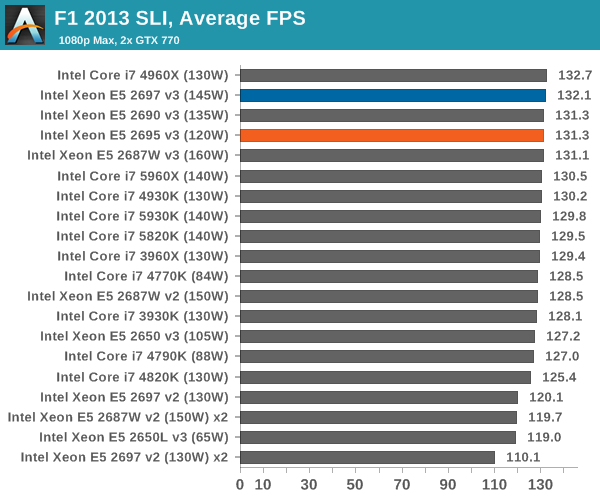
Bioshock Infinite
Bioshock Infinite was Zero Punctuation’s Game of the Year for 2013, uses the Unreal Engine 3, and is designed to scale with both cores and graphical prowess. We test the benchmark using the Adrenaline benchmark tool and the Xtreme (1920x1080, Maximum) performance setting, noting down the average frame rates and the minimum frame rates.
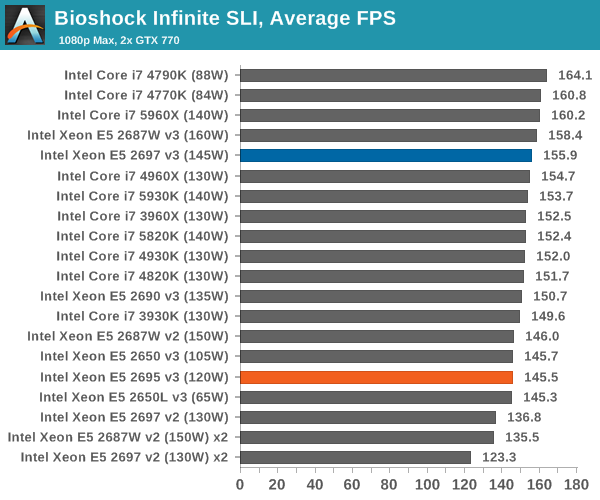
Tomb Raider
The next benchmark in our test is Tomb Raider. Tomb Raider is an AMD optimized game, lauded for its use of TressFX creating dynamic hair to increase the immersion in game. Tomb Raider uses a modified version of the Crystal Engine, and enjoys raw horsepower. We test the benchmark using the Adrenaline benchmark tool and the Xtreme (1920x1080, Maximum) performance setting, noting down the average frame rates and the minimum frame rates.
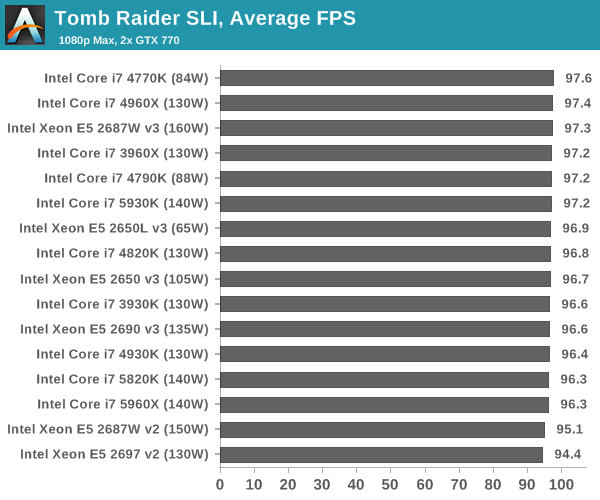
Notice zero results from Tomb Raider from our new CPUs? This benchmark does not seem to like any arrangement above 12 cores per socket, and refuses to run.
Sleeping Dogs
Sleeping Dogs is a benchmarking wet dream – a highly complex benchmark that can bring the toughest setup and high resolutions down into single figures. Having an extreme SSAO setting can do that, but at the right settings Sleeping Dogs is highly playable and enjoyable. We run the basic benchmark program laid out in the Adrenaline benchmark tool, and the Xtreme (1920x1080, Maximum) performance setting, noting down the average frame rates and the minimum frame rates.
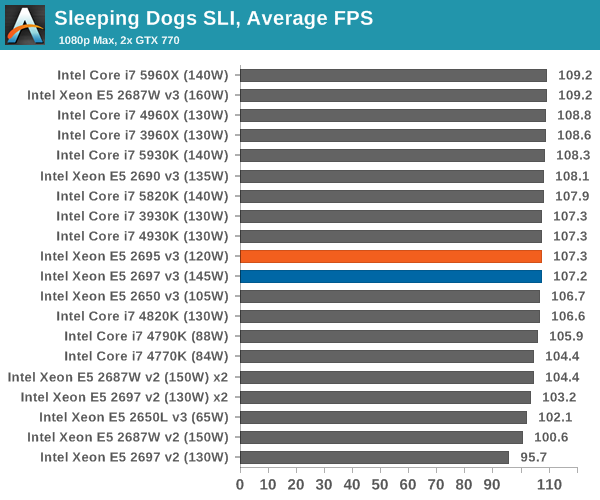
Battlefield 4
The EA/DICE series that has taken countless hours of my life away is back for another iteration, using the Frostbite 3 engine. AMD is also piling its resources into BF4 with the new Mantle API for developers, designed to cut the time required for the CPU to dispatch commands to the graphical sub-system. For our test we use the in-game benchmarking tools and record the frame time for the first ~70 seconds of the Tashgar single player mission, which is an on-rails generation of and rendering of objects and textures. We test at 1920x1080 at Ultra settings.
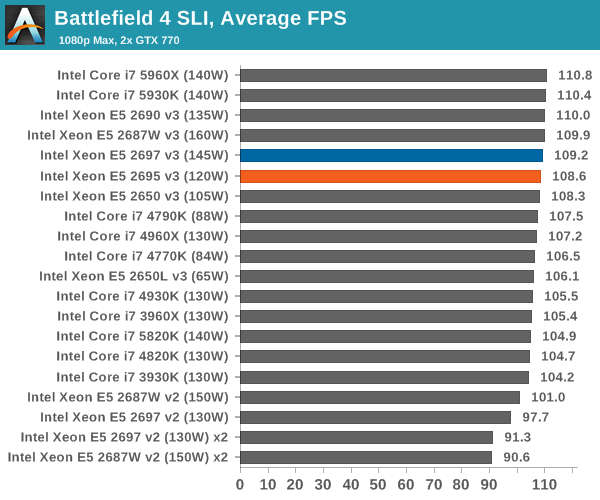















44 Comments
View All Comments
bill.rookard - Thursday, November 20, 2014 - link
I don't think I'd want one. If you notice, a majority of the benchmarks which a normal person might find useful the i7-4790K came in highest and flat out won 12 of those benchmark tests. And of course it costs about 1/10th the price.MrSpadge - Thursday, November 20, 2014 - link
Since he's reading AT I don't think he's a normal "person" ;)dgingeri - Thursday, November 20, 2014 - link
you're right about that. I'm a systems admin in a test lab. I'd want it for my VM practice system. A Core i7 3930k isn't quite as nice to run a dozen VMs as I had hoped.cjcoats - Thursday, November 20, 2014 - link
About those Linux benchmarks:1) That "NPB, Fluid Dynamics" reports millions of operations _per thread_, which is deceptive as regards actual delivered "in your face" work performed per wall-clock time; the existing chart should be supplemented by one giving [ops per thread per sec]*[number of threads] -- i.e., total ops per sec, which is what I really care about.
2) For Linux benchmarks in general: what compiler and compile-flags? ...and is this "one binary for all the machines"? The performance can be greatly influenced by targeting the actual processor architecture ("-xHost" for Intel compilers, "-march=native -mtune=native" for Gnu. For the codes I use and the (SandyBridge or later) servers I use, targeting the architecture I'm running on typically may give as much as a 70% boost, which is nothing to sneer at when my run-times are measured in hours or even days.
mapesdhs - Friday, November 21, 2014 - link
Re your 2nd point, that's certainly true for th C-ray test. One can do all sorts of optimisationsto show huge performance gains which are not remotely realistic. Wouldn't surprise me if this
affects the other tests too.
Ian.
FriendlyUser - Thursday, November 20, 2014 - link
Will it play Assassin's Creed: Unity?anubis44 - Thursday, November 20, 2014 - link
You forgot to say: "BUT can it run (insert terribly optimized pig-of-a-game here) ?"Cravenmor - Thursday, November 20, 2014 - link
Enjoying my coffee...Laststop311 - Thursday, November 20, 2014 - link
These xeons are just crazy priced. I would be happy with an i7-5960k clocked at 4.2ghz to match my i7-980x clocked at 4.2ghz. But really even after 4 years the performance increase still does not justify spending close to 2000 on cpu + x99 mobo + 4x8GB ddr4. Since broadwell is just a tick broadwell-e probably wont justify the expense either so maybe after 6 years have passed with gulftown skylake-e will finally make the expense worth it. Even if not the extra features like pci-e connected storage, ddr4 and pci-e 4.0 will finally make it worth it. By then the ridiculous ddr4 ram prices should be in line with how ddr3 is priced now too.wallysb01 - Thursday, November 20, 2014 - link
You must not be doing much heavily threaded work then, because for those that are the total system performance delivered with say, a $7K workstation, has gone through the roof compared to westmere.For example, the X5660 was 6 cores at 2.8GHz and the E5-2650v3 is 10 cores at 2.3GHz, but actually operates at 2.5GHz (something westmere didn’t do with the difference in turbo binning), both for a little over $1000 bucks each. Then, if we add 5% performance per generation, that brings the 2.5GHz to 2.9 “westmere equivalent” GHz. Then the 10 core vs 6 core means the E5-2650v3 is giving you 70% more performance than the X5660 did.